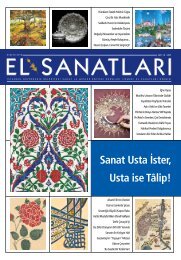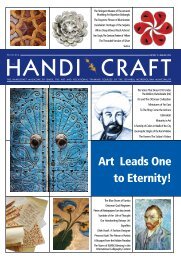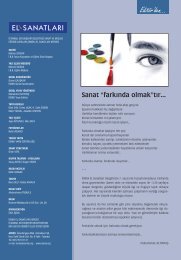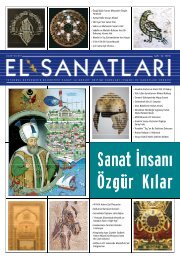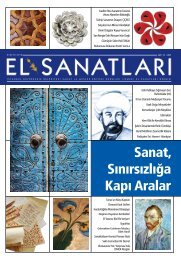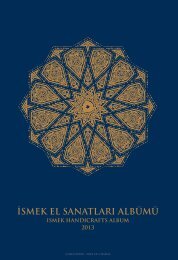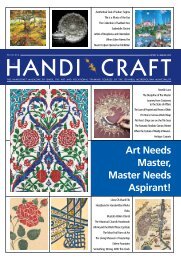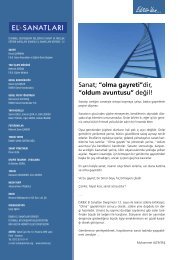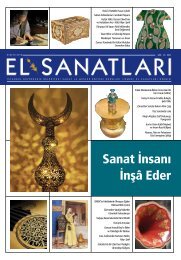Download Link - Ä°SMEK
Download Link - Ä°SMEK
Download Link - Ä°SMEK
You also want an ePaper? Increase the reach of your titles
YUMPU automatically turns print PDFs into web optimized ePapers that Google loves.
serve a syrup made of honey and sugar during special<br />
nights, on ied days and on Fridays. Also, another tradition<br />
was serving syrup during the first few days after the<br />
opening of a water serving building building. Usually,<br />
when someone wanted to drink water or syrup, the water<br />
server used to serve the water or syrup in bowls which<br />
were made of copper, brass or artificial gold. The bowls<br />
were attached to the water serving building with chains,<br />
and they had handles on them.<br />
Almost all the water serving building buildings in Uskudar,<br />
except for 3 of them, are located between the big<br />
Uskudar Pier and the tomb of Karacaahmet. This was the<br />
only route which connected Istanbul to Anatolia during<br />
the reign of the Roman Empire, The Byzantine Empire and<br />
The Ottoman Empire. All travellers who prepared to go to<br />
Anatolia by using the pier would first stop by the tomb of<br />
Hudayi Hazretleri to pray there, and drink water from its<br />
water serving building. Then they would climb the Menzilhane<br />
slope to come to the place where the tomb of<br />
Karacaahmet was located. This location, which had 12<br />
water serving buildings, was a praying and gathering<br />
point for travellers.<br />
The Ahmediye Mosque Water serving building is located<br />
on Gundoğumu Avenue (Ahhmediye Avenue before.)<br />
It was built in 1721-22, together with the Ahmediye<br />
Mosque, the Ahmediye Madrasah, the Ahmediye School,<br />
the Ahmediye Library and the ahmediye Fountain. Being<br />
the most elegant and beautiful work of its era, this college<br />
was built by Fiduciary Hacı Ahmet ağa.<br />
To the right of the water serving building is the yard gate<br />
to the Ahmediye mosque and the marble Ahmediye<br />
Fountain. Above it, is located the Ahmediye School. Made<br />
of pure marble, the water serving building has 3 windows<br />
made of gridiron, which were placed in 4 thin columns.<br />
The columns whose heads had stalactites are connected<br />
to one another with marble archs. It has a 12-versed epigraph,<br />
whose pairs of verses are divided and written in<br />
different places of the water serving building. There is a<br />
pair under the wooden eaves, on the peacock tail, and on<br />
each Window pane. This epigraph continues also on the<br />
marble archs above the window. The following is this epigraph,<br />
which is comprised of 20 verses in total: Eminzade<br />
cenab-ı hacı Ahmed kim bu alemde/ Ana oldu muyesser<br />
hak-bus-i Kabe-i ulya / Zehi ziba sebil-i ma-i selsal-i musaffa-ter<br />
/ K’olur nuş eyledikçe ayn-ı Zemzem-veş safa-bahşa.<br />
Idub teşmir bazu-yi futuvvet fi-sebilillah / Pur itdi<br />
ni’met-i hayr ile Çeşm-i Kepçeyi hakka / Terazide n’ola<br />
tartılsa âbı durr u guherle / Letafetde ana lulesi lala olamaz<br />
hemta. / Ataş-ı nase bir ab-ı musaffayı sebil itdi<br />
/ Yenabi-i himemden bu mahalle eyleyub icra / Safa-yı<br />
lezzetini bir kez duşunde Kuh-ken görse / Iderdi ömru<br />
oldukca leb-i Şirin’den istiğna. Aceb mi teşne lebler olsa<br />
şirin-kam da’valı / Ziyafet eyledi atşane şehd u şir ile<br />
guya / Idub hayratını mebrur ide Hakk sa’yini meşkur<br />
/ Mu’in ola hemişe ana lutf-i hazret-i Mevla Gelen dilteşneye<br />
her kuzesi Salim didi tarih / Zulal-i paki nuş it bu<br />
sebil-i abden sıhha.<br />
The epigraph was prepared by the Poet şair kazasker Mirzazâde<br />
Sâlim Mehmet Emin Efendi. He is the son of Mirza<br />
Mustafa Efendi, who was a chief religious official, and who<br />
died in 1722. Having a good Madrasah education, Salim<br />
Efendi served a number of duties, and then was assigned as<br />
a judge to Mekka in 1736-37, and then was ordered to go to<br />
Damascus in 1738. He died in April 1739, in Mefrik, a place<br />
between Tripoly and damascus, and was buried there. 13<br />
The Ahmediye Mosque Library<br />
Located in the Ahmediye district, the Ahmediye Mosque Library<br />
belongs to the Ahmediye College, and was built on the<br />
top flor of the college in 1721-22 by the Navy Yard Fiduciary<br />
Ahmed Ağa.<br />
The yard gate on Esvapçı Street, which leads up to the library<br />
via a staircase is therefore called the library gate. This<br />
gate has no epigraphs. A narrow door is used to enter the<br />
library. The long corridor leads to 2 steps made of Stone, and<br />
then a platform. After turning 360 degrees on this platform,<br />
10 steps lead up to another platform in front of the library.<br />
This platform is blanketed with 3 domes carried by 6 marble<br />
columns. To the left of the library are a small fountain and<br />
toilets. The water from the fountain is carried by water bearers.<br />
Its only big and blind dome mounts on an 8-sided hoop.<br />
It is enlightened by 13 windows subjacent to one another.<br />
When entered from its arched and marble jambed door, we<br />
see that there is a cupboard with 2 divisions, as well as a<br />
3-layered marble nich on the left hand side. Straight ahead<br />
is a veiled stove.<br />
There are no epigraphs on its door. Located on Esvapçı Street<br />
side of the college, it was built totally of hewn Stone, one<br />
corner extended outwards on consoles. The architect of the<br />
library is Mehmed Ağa of Kayseri, who was a chief designer<br />
of the Tulip Era. The library also has a deed of trust dated<br />
1139 by the Islamic calendar. Sami Mehmed Efendi donated<br />
50 books to the library.<br />
In the interior part of the building which serves as a Quran<br />
teaching center today, there is a stove, 2 cupboards and 3<br />
carved marble niches. On the street side of the library, we can<br />
see 2 small bird houses which mount on consoles placed on<br />
an area between the consoles which fill the space between<br />
the grandfloor and first flor, and the top window with pointed<br />
arches. The alcoved side arrangement, where the alcoves<br />
are placed on consoles which are underneath the tiny flor<br />
rooms, was quite a popular arrangement used in libraries<br />
built for madrasahs and schools for little children during 18 th<br />
century. Among the best known examples of this are, the<br />
Hekimoğlu Ali Pahsa library (1732), the Vefa Şehit Ali Pahsa<br />
Library (1715) and the Aksaray Suleyman Halife College for<br />
little children (1728). 14<br />
The Ottoman Style Gravestones And<br />
The Ahmediye Camii Burial Place<br />
Another colourful set of dreams that those who live in Istanbul<br />
see, are the graveyards which symbolise the frail<br />
tie between life and death. In districts such as Fatih, Eyup<br />
and Uskudar, where the settlement is relatively older than<br />
the other places in Istanbul, the ancient graveyards which<br />
159



